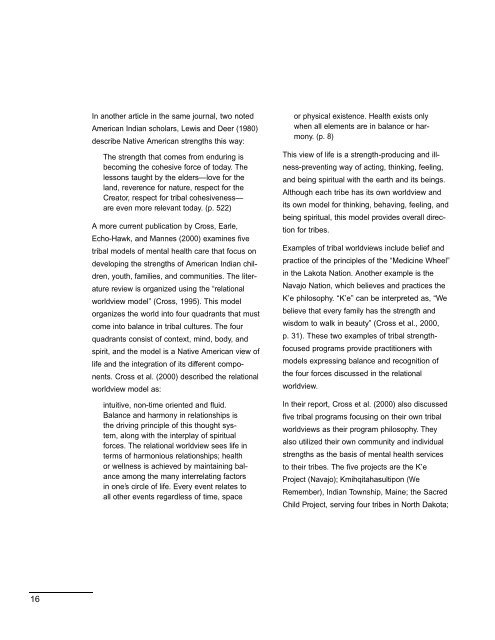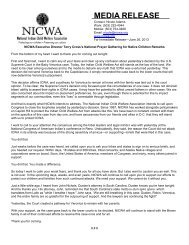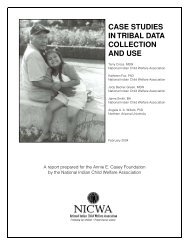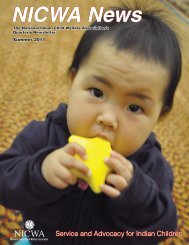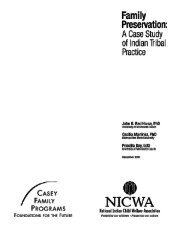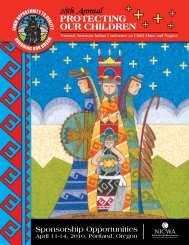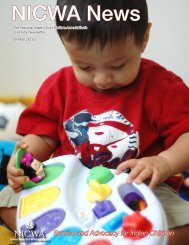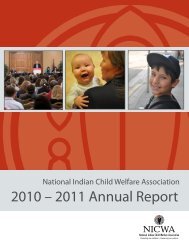Native American Children and Youth Well-Being Indicators
Native American Children and Youth Well-Being Indicators
Native American Children and Youth Well-Being Indicators
Create successful ePaper yourself
Turn your PDF publications into a flip-book with our unique Google optimized e-Paper software.
In another article in the same journal, two noted<strong>American</strong> Indian scholars, Lewis <strong>and</strong> Deer (1980)describe <strong>Native</strong> <strong>American</strong> strengths this way:The strength that comes from enduring isbecoming the cohesive force of today. Thelessons taught by the elders—love for thel<strong>and</strong>, reverence for nature, respect for theCreator, respect for tribal cohesiveness—are even more relevant today. (p. 522)A more current publication by Cross, Earle,Echo-Hawk, <strong>and</strong> Mannes (2000) examines fivetribal models of mental health care that focus ondeveloping the strengths of <strong>American</strong> Indian children,youth, families, <strong>and</strong> communities. The literaturereview is organized using the “relationalworldview model” (Cross, 1995). This modelorganizes the world into four quadrants that mustcome into balance in tribal cultures. The fourquadrants consist of context, mind, body, <strong>and</strong>spirit, <strong>and</strong> the model is a <strong>Native</strong> <strong>American</strong> view oflife <strong>and</strong> the integration of its different components.Cross et al. (2000) described the relationalworldview model as:intuitive, non-time oriented <strong>and</strong> fluid.Balance <strong>and</strong> harmony in relationships isthe driving principle of this thought system,along with the interplay of spiritualforces. The relational worldview sees life interms of harmonious relationships; healthor wellness is achieved by maintaining balanceamong the many interrelating factorsin one’s circle of life. Every event relates toall other events regardless of time, spaceor physical existence. Health exists onlywhen all elements are in balance or harmony.(p. 8)This view of life is a strength-producing <strong>and</strong> illness-preventingway of acting, thinking, feeling,<strong>and</strong> being spiritual with the earth <strong>and</strong> its beings.Although each tribe has its own worldview <strong>and</strong>its own model for thinking, behaving, feeling, <strong>and</strong>being spiritual, this model provides overall directionfor tribes.Examples of tribal worldviews include belief <strong>and</strong>practice of the principles of the “Medicine Wheel”in the Lakota Nation. Another example is theNavajo Nation, which believes <strong>and</strong> practices theK’e philosophy. “K’e” can be interpreted as, “Webelieve that every family has the strength <strong>and</strong>wisdom to walk in beauty” (Cross et al., 2000,p. 31). These two examples of tribal strengthfocusedprograms provide practitioners withmodels expressing balance <strong>and</strong> recognition ofthe four forces discussed in the relationalworldview.In their report, Cross et al. (2000) also discussedfive tribal programs focusing on their own tribalworldviews as their program philosophy. Theyalso utilized their own community <strong>and</strong> individualstrengths as the basis of mental health servicesto their tribes. The five projects are the K’eProject (Navajo); Kmihqitahasultipon (WeRemember), Indian Township, Maine; the SacredChild Project, serving four tribes in North Dakota;16


